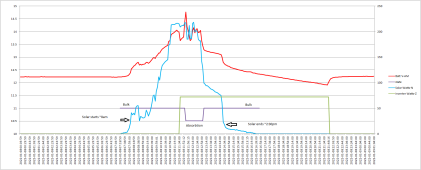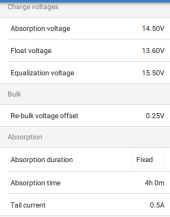Hello all, I am hoping that someone could help me with a lead acid battery charging issue that I have been having. The way I have configured my charge controller & load does not seem to allow for the batteries to get to full charge.
I am not looking for specific device settings, more for the theory of how to properly charge a lead acid battery correctly to near full capacity (if possible) while there might be an automated on/off load connected.
For information on what I am using: the items include a Victron 75/15 MPPT CC, a phoenix inverter, a Victron BMS 712, a new 100A/h deep cycle lead acid battery and 3-100W solar panels. I have the CC set for 14.5 absorption, 13.6 float. I have the inverter set for a charge detect of 14.6 and dynamic disconnect of 11.5-12V (about 50% of the battery via Voltage). The 100A/h battery at 50% should give me ~600W/h usable. I actually had more of the same deep cycle batteries in parallel but for the purpose of this testing reduced it to one battery.
I started out with the MPPT charge controller, Phonix inverter, a fully charged battery and solar. The load via the inverter is my office equipment and is fairly static at 70Watts and got approximately 8 hours of run time until the inverter disconnected at ~12V (approx. 550 W/h). After several days I found I was only getting about 3-4 hours of inverter run time.
I bought a Victron BMS712 to better understand how the amp capacity worked and found I was pulling more amps from the battery than I was putting back via solar (as the inverter attached was turning on automatically).
There are hundreds of articles on how to properly charge a lead acid battery, but they all are done with a standalone battery and charger (no load on the battery during the charging). Most articles say that 80% of putting back the capacity is done in the bulk phase and the other 20% done in absorption phase that will take hours.
My inverter turns on when the voltage gets to the absorption phase 14.5v and on some days, there is not enough solar power to run the load directly, so it uses the battery thus never allowing the battery to get to 100%.
If I just let it run this way the battery will most likely cycle between 50%SOC and ~85%SOC, maybe hitting 100% on the very sunning days, obviously ruining the life of a lead acid battery if not brought to 100% often. If I add more solar than I moved the problem from not filling up the batteries to not using all of the solar capacity (I could just put a smaller battery in to achieve that result).
You would think the first option is to not turn on the inverter until the battery reaches the float stage (using the remote connection on the inverter and load output on the MPPT connected), but #1) The Victron inverter does not have this as an option in the load settings (really Victron...?) and #2) I would not like to use this anyway as hours of strong solar time might go by not being used during the absorption hours that pull little amps to charge the battery.
Another option is to use the relay output of the BMS and trigger the inverter on when the battery has a good SOC (% of full) but again if I start at say 90% the battery still would not be full and the above would still happen. If I wait too long ~99% I am wasting solar energy during absorption.
Sorry for this long description but wanted to get out what I am dealing with. Hoping I am not overthinking this, there are years of use of lead acid batteries doing the above and hoping someone can help me understand if I am doing something wrong / not understanding something.
Thanks in advance,
Matt
I am not looking for specific device settings, more for the theory of how to properly charge a lead acid battery correctly to near full capacity (if possible) while there might be an automated on/off load connected.
For information on what I am using: the items include a Victron 75/15 MPPT CC, a phoenix inverter, a Victron BMS 712, a new 100A/h deep cycle lead acid battery and 3-100W solar panels. I have the CC set for 14.5 absorption, 13.6 float. I have the inverter set for a charge detect of 14.6 and dynamic disconnect of 11.5-12V (about 50% of the battery via Voltage). The 100A/h battery at 50% should give me ~600W/h usable. I actually had more of the same deep cycle batteries in parallel but for the purpose of this testing reduced it to one battery.
I started out with the MPPT charge controller, Phonix inverter, a fully charged battery and solar. The load via the inverter is my office equipment and is fairly static at 70Watts and got approximately 8 hours of run time until the inverter disconnected at ~12V (approx. 550 W/h). After several days I found I was only getting about 3-4 hours of inverter run time.
I bought a Victron BMS712 to better understand how the amp capacity worked and found I was pulling more amps from the battery than I was putting back via solar (as the inverter attached was turning on automatically).
There are hundreds of articles on how to properly charge a lead acid battery, but they all are done with a standalone battery and charger (no load on the battery during the charging). Most articles say that 80% of putting back the capacity is done in the bulk phase and the other 20% done in absorption phase that will take hours.
My inverter turns on when the voltage gets to the absorption phase 14.5v and on some days, there is not enough solar power to run the load directly, so it uses the battery thus never allowing the battery to get to 100%.
If I just let it run this way the battery will most likely cycle between 50%SOC and ~85%SOC, maybe hitting 100% on the very sunning days, obviously ruining the life of a lead acid battery if not brought to 100% often. If I add more solar than I moved the problem from not filling up the batteries to not using all of the solar capacity (I could just put a smaller battery in to achieve that result).
You would think the first option is to not turn on the inverter until the battery reaches the float stage (using the remote connection on the inverter and load output on the MPPT connected), but #1) The Victron inverter does not have this as an option in the load settings (really Victron...?) and #2) I would not like to use this anyway as hours of strong solar time might go by not being used during the absorption hours that pull little amps to charge the battery.
Another option is to use the relay output of the BMS and trigger the inverter on when the battery has a good SOC (% of full) but again if I start at say 90% the battery still would not be full and the above would still happen. If I wait too long ~99% I am wasting solar energy during absorption.
Sorry for this long description but wanted to get out what I am dealing with. Hoping I am not overthinking this, there are years of use of lead acid batteries doing the above and hoping someone can help me understand if I am doing something wrong / not understanding something.
Thanks in advance,
Matt






